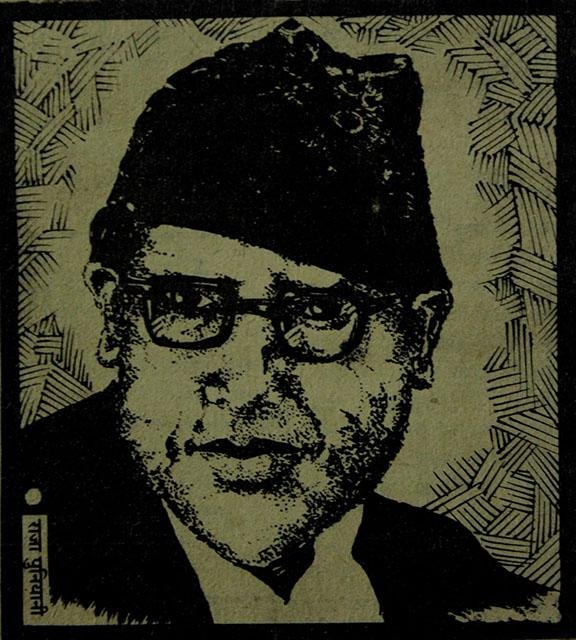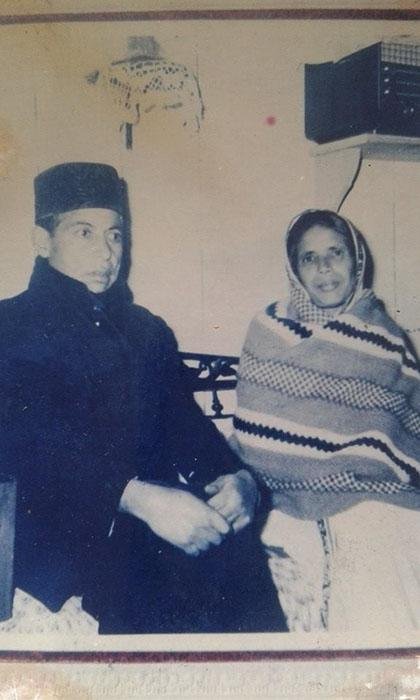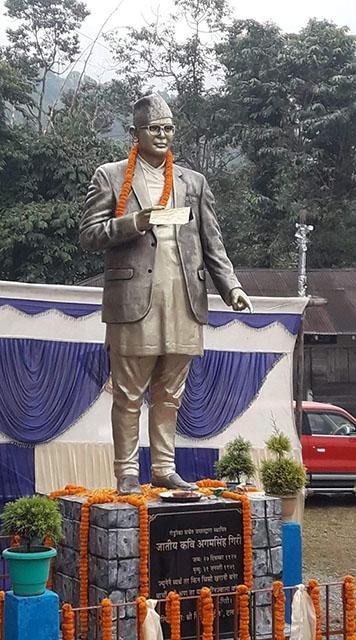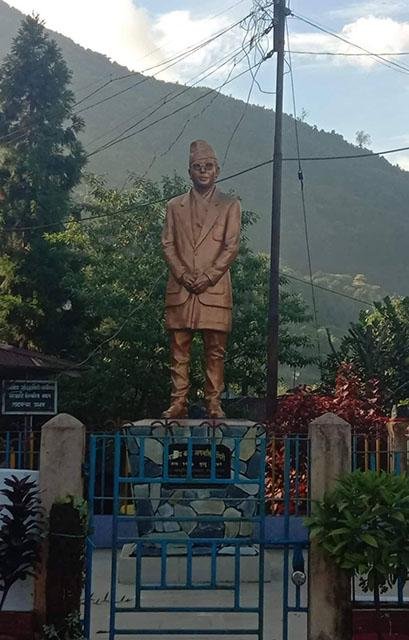You have become unrecognisable here
Agam Singh Giri
Blood in your cheeks has dried up
The light in your eyes is gone
You look like a child who has fallen asleep, sobbing
Like a prisoner tortured long
The ill-fated whose morsels are snatched away
And the house dispossessed
I have come only to see whether you are ‘You’
But, you have become unrecognisable

Agam Singh Giri is known as the first-ever poet to highlight the aspiration of the Gorkha people through literary endeavours. He is mainly remembered by the Gorkha community for passionately inscribing the consciousness of ‘identity’ on the social psyche. He addressed the issue of the ‘identity crisis’ is deeply felt by the marginal Gorkha community inhibiting India since the British era. He appealed to the Gorkha mass to raise their consciousness to be active to claim the identity lost in the complex contradiction of Indian and Nepalese political gamut.
Giri is known for his powerful poetic expressions. He is specially recalled time and again for his masterpiece hallmark work ‘Yudhha ra Yodhha’ a micro epic. He criticizes the essence of war and appeals to the Gorkha people to discourage themselves to be the tools for the imperial wars and wage their own war of consciousness for the cause of Gorkha Identity in the Indian political framework. He criticizes the oblivion of Gorkha consciousness through him masterpiece poetry ‘Nachinine Bhayechhau’.
The legendary Nepali poet Agam Singh Giri frequently expressed his melancholy in his writings, and his poetry often has an overpowering sadness. Giri’s grief was not a result of any personal experience, but it was part of who he was. Later, it became sharper and the poet became more discursive as a result of his deep realisation of the tragic predicament of the Indian Gorkhas. But most of Giri’s best poetry belongs to the latter group, which includes the majority of his best works.
Early Life and Education
Giri was born in Darjeeling on December 27, 1927. He was not just an Indian poet of the Nepali language but also a popular lyricist. His highly popular song ‘Naulakhey Tara Udayo’ was indulged in controversy. Giri was born in Darjeeling’s Maiden neighbourhood, close to Chaurasta. Hemraj Giri, the oldest of the eight children born to Chhabilal and Bimala Giri, was given that name when he was born. Agamsingh Giri’s family moved from Maiden to Ramgarh Bhavan in Chandmari when he was three years old.
Chhabilal Giri taught pre-primary education to Agam Singh Giri. He attended St. Robert’s High School for his elementary and secondary education, but he had to leave in class IX and was unable to finish his education. Later, in 1948, he enrolled at the Teacher’s Training College in Kalimpong.
Even though he was unable to complete any university coursework or earn a degree, he continued his own study.

Courtesy: Nagendra Gorkha
Influences and Inspiration
Giri took his inspiration from the many intellectuals from different fields from whom he had maintained positive contacts. He got along well with politicians like Dambar Singh Gurung and Deo Prakash Rai, social workers like Swami Prabhudananda, literary greats like Surya Bikram Gyawali, Dharnidhar Koirala, Dr. Indrabahadur Rai, Parasmani Pradhan, Rupnarayan Sinha, Ramkrishna Sharma, and Accha Rai Rasik, among many others.
Agam Singh Giri was inspired by English, Hindi, and Bengali poets in addition to being impacted by literary figures who wrote in Nepali. Lord Byron, John Keats, William Wordsworth, Sumitranandan Pant, Jayashankar Prasad, Suryakant Tripathi “Nirala,” Rabindranath Tagore, Sarat Chandra, and Bankim Chandra were just a few of the authors he closely followed.
After being influenced by Jayashankar Prasad, who had published “Anshu” in 1925, Giri released his work with the same title, ‘Anshu’ (tears) in 1968.
Personal Life
Agam Singh Giri had two marriages. With his first wife, Dilu Giri, he had two kids. Gita Giri, his daughter, died when she was a little child. Two daughters, Bindu and Indu Giri, were born to his second wife, Bina Giri. 1954 saw the death of Indu. The poem, ‘Yi Dui Phul’ (These two blossoms) was written by Giri in honour of his two children, Gagan and Indu. On the passing of his daughter Indu, he also composed a poem titled ‘Ankha Chimliyepachi’ (After she closed her eyes).
Personality and Occupation
Giri was endearing and frequently wore Daura Suruwaal and Dhaka Topi, traditional Nepali clothing. As soon as Giri left St. Robert’s School in 1948, he began working as a volunteer teacher at Surottam Ratri Vaidik Pathsala in Chandmari. After receiving recognition, the school adopted the name “Bhanubhakta Primary School,” and Giri continued to work there until his passing.
Contributions To Nepali Literature
Giri is frequently referred to be a revolutionary poet because we can see elements of freedom fighters and atrocities in all of his published poems. His creative output is a reflection of his passion for the land, the language, and the Nepal community. The poem by Giri also expresses the poet’s sorrowful knowledge of the miserable situation faced by Indian Gorkhas. He is credited as being the first poet from Darjeeling to be able to ingrain these feelings in his audience.
It wouldn’t be incorrect to suggest that a poet who was born and nurtured in Darjeeling assumed the entire responsibility for transmitting the cultural identity of the Darjeeling people through his literary creations. He was even given the moniker “The National Poet of the Gorkhas” by GNLF, the political party in the hills.
Agam Singh Giri’s poetry such as ‘Yaad’ (rememberance), ‘Aatma Byathha’ (soul’s sorrow), ‘Aanshu’ (Tears), ‘Jiwan Geet’ (Life’s song), ‘Yuddha ra Yoddha’ (War and fighter), and ‘Jaleko Pratibimba ra Royeko Pratidhwani’ (Burnt image and a weeping echo) are included in his published works. The first collection was released in 1955, and the final one was released after the author’s passing in 1978. The Nepali Academy of West Bengal bestowed the Bhanu Puraskar on the most recent piece in 1979. Additionally honoured with the Ratnashree Gold Award was Agam Singh Giri.

Sculpture – Amir Sundas Courtesy: Publiknama
Giri was a master at using figures of speech in his writing. The figure of speech is a type of communication that purposefully departs from the usual manner of speech in order to have a stronger, more appealing, or more distinctive impression. In addition to the figure of speech, he also used personification, which is the representation of inanimate objects, abstract ideas, or qualities as people.
Death
On January 31, 1971, at the age of 44, Agam Singh Giri passed away suddenly at his own house. He had a terrible drinking habit that cost him his life.

Courtesy: Publiknama
Indra Bahadur Rai on Agam Singh Giri
Another Gorkha literary legend, Late Indra Bahadur Rai has written about Giri that a year before his passing, Giri wrote his final book, War and the Warrior (1970), in which he addressed the central theme of Nepalese life in India: the search for self-identity. It is not at all pleasant to be referred to as “mercenaries of war” because Nepalese are an aggressive but misunderstood race that has long been engaged in waging other men’s wars. All Nepalese mothers would be forbidden by Giri from giving birth to boys who would only perish in foreign wars.
Agamsingh Giri, a young man who would go on to become the poet most closely associated with Indian Nepalese, fully absorbed the principles and message of Naivedya – a collection of poems by Pandit Dharanidhar Sharma. Giri expressed the prevailing sense of widespread discontent among his people in poetry that excelled in their lyrical brilliance. Indian Nepalese had made a significant contribution to achieving Indian Independence.
The Indian Nepali Community is, nevertheless, consigned to the position of helpless witnesses, frequently of their own extinction, under the new “democratic” framework where numbers (votes) alone matter. This perspective should also be applied to the literature of India’s minority nationalities and the disaffected voters within them. And if they haven’t yet created anything of significant national significance for all of India, they shouldn’t really be held accountable.
O Warrior,
an excerpt from War and the Warrior / Yudha ani Yoddha (1970)
your son is yet to be born,
he shall be then a part of your life,
allow him not to be wounded
spilling blood for others
forbid him to sharpen his Khukuri
to fight other men’s battles,
to add shine to other’s existence;
history will only brand him a murderer,
let him not be accursed by all
or consigned to insults and injuries
we are in midst of war
we have fought and have somehow survived
there is a cry of fear in our heart
war, not understood,
is starkly visible in our eyes.




An informative article!
Comments are closed.